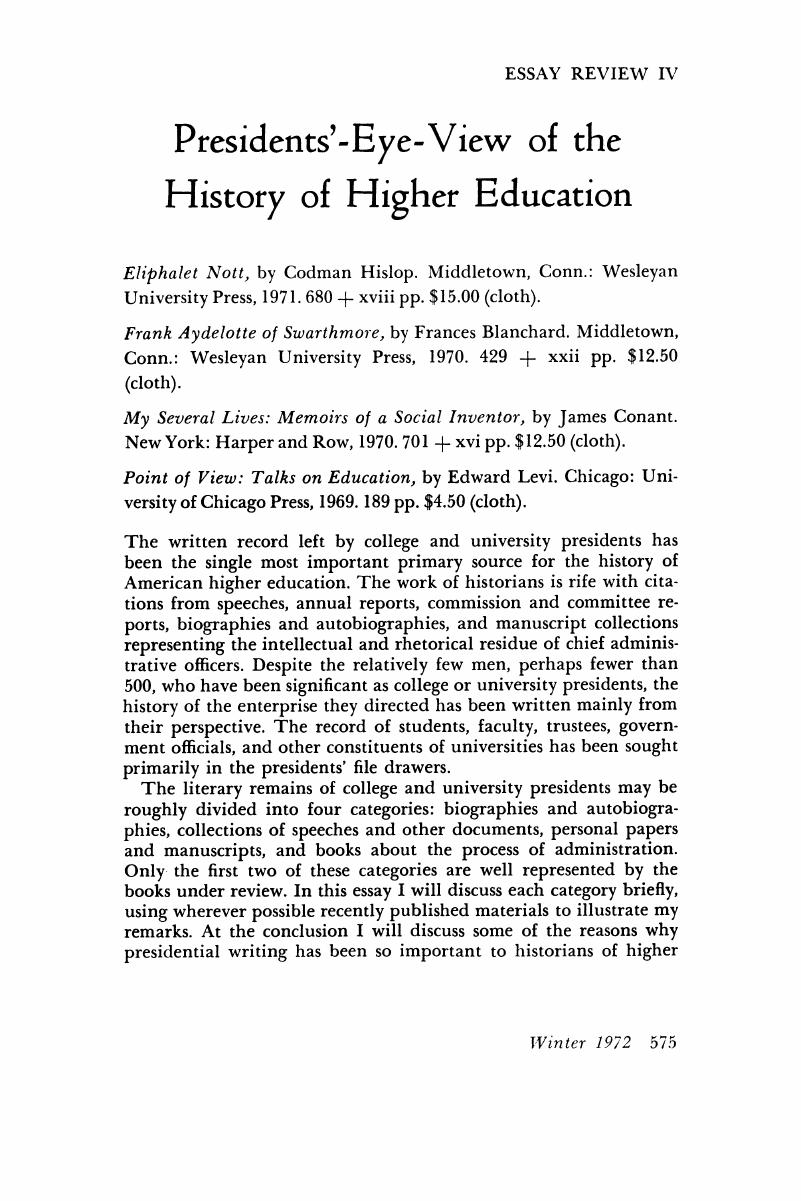Article contents
Presidents'-Eye-View of the History of Higher Education
Published online by Cambridge University Press: 24 February 2017
Abstract

- Type
- Essay Review IV
- Information
- Copyright
- Copyright © 1973 by New York University
References
Notes
1. Morgan, Edmund, The Gentle Puritan: A Life of Ezra Stiles 1727–1795 (New Haven, 1962); Tucker, Louis, Puritan Protagonist: President Thomas Clapp of Yale College (Chapel Hill, 1962); Crane, Theodore, Francis Wayland: Political Scientist as Educator (Providence, 1962); Miller, Perry, Jonathan Edwards (Boston, 1949).Google Scholar
2. Bragdon, Henry W., Woodrow Wilson: The Academic Years (Cambridge, Mass., 1967).CrossRefGoogle Scholar
3. Ben-David, Joseph, American Higher Education: Directions Old and New (New York, 1972); Ringer, Fritz, The Decline of the German Mandarins: The German Academic Community, 1890–1933 (Cambridge, Mass., 1969); Veysey, Lawrence, The Emergence of the American University (Chicago, 1965).Google Scholar
4. White, Andrew Dickson, Autobiography (New York, 1904); Hall, G. Stanley, Life and Confessions of a Psychologist (New York, 1923); Butler, Nicholas Murray, Across the Busy Years (New York, 1935); Millikan, Robert, Autobiography (New York, 1950).Google Scholar
5. Summerskill, John, President Seven (Cleveland, 1970).Google Scholar
6. Grennan, Jacqueline, Where I Am Going (New York, 1968).Google Scholar
7. Kerr, Clark, The Uses of the University (Cambridge, 1963); Perkins, James, The University in Transition (Princeton, 1966); Wayland, Francis, Thoughts on the Present Collegiate System in the United States (Boston, 1842).Google Scholar
8. James, Henry, Charles William Eliot (Boston, 1930); Shaw, Wilfred B., ed., From Vermont to Michigan: Correspondence of James Burrill Angell, 1869–1871 (Ann Arbor, 1936).Google Scholar
9. For some happy exceptions to these generalizatons, see Herbst, Jurgen, The German Historical School in American Scholarship (Ithaca, 1965); Rader, Benjamin, The Academic Mind and Reform: The Influence of Richard T. Ely in American Life (Lexington, 1966); and Harris, Seymour, The Economics of Harvard (New York, 1970).Google Scholar
10. Nineteenth-century discourses on college government, such as Barnard's, F. A. P., Letters on College Government (New York, 1855), should not be confused with writing about the art or science of administration. The former books dealt with the control of students.Google Scholar
11. Eliot, Charles William, University Administration (Boston, 1908); Thwing, Charles F., College Administration (New York, 1900) and The College President (New York, 1926).Google Scholar
12. See for examples the following articles: Butler, Nicholas Murray, “University Administration in the United States,“ Educational Review 41 (April 1911): 325–44; Pritchard, Henry, “Shall the University Become a Business Corporation?” Atlantic Monthly 96(1906): 289–99; Andrews, E. Benjamin, “The Organization of the University and the Distribution of Authority Therein,” Proceedings of the National Association of State Universities 5 (1907): 114–21; and Draper, Andrew S., “The University Presidency,” Atlantic Montly 97 (1906): 34–43.Google Scholar
13. Finley, John H. and Sanderson, John F., The American Executive and Executive Methods (New York, 1918); and Elliott, Edward C., The Government of Higher Education (New York, 1935). For the purposes of this essay, one might include two classic articles that are not easily classified: Woodrow Wilson's “The Study of Administration,” Political Science Quarterly 2 (1887): 197–222, forecast virtually every aspect of scientific administration as the twentieth century came to know it. Conant's, James, “Academical Superintendence and Patronage,” Harvard Educational Review. 8 (May 1938): 312–34, should rightly be called “an autobiographical sojourn, with comments, through British and American literature on university administration.”Google Scholar
14. Capen, Samuel, The Management of Universities (Buffalo, N.Y., 1953); Stoke, Harold, The American College President (New York, 1959); and Dodds, Harold, The Academic President: Educator or Caretaker? (New York, 1962).Google Scholar
15. Ritchie, M. A. F., The College Presidency: Initiation into the Order of the Turtle (New York, 1970); Birenbaum, William M., Something for Everybody is Not Enough (New York, 1972); Weinberg, Alvin, Reflections on Big Science (Cambridge, 1967).Google Scholar
16. Dozens of administrators with lesser titles have written books and left records far more worthy of comment than those produced by most university presidents. Using the groupings developed for this essay, one thinks at once of the biography of Seaman Knapp, by Bailey, Joseph (New York, 1945), the autobiography of Cross, Wilbur (New Haven, 1943), the outspoken analyses by Barzun, Jacques and Nisbet, Robert, and the graceful admonitions of Brown, C. Douglas. The research on administration by Ruml, Beardsley and Mark Ingraham probably influenced higher education more than any presidential writing, as did the leadership of Edward Litchfield as editor of Administrative Science Quarterly. All of these men were deans at well-known institutions.Google Scholar
- 1
- Cited by




